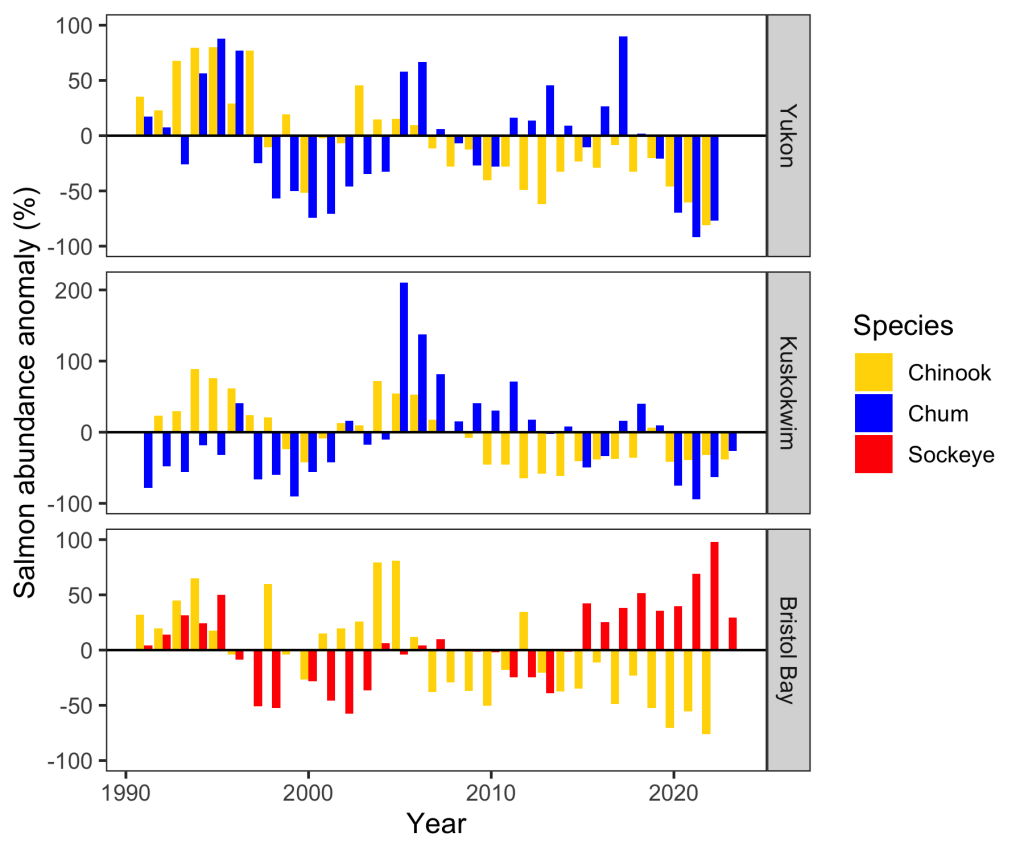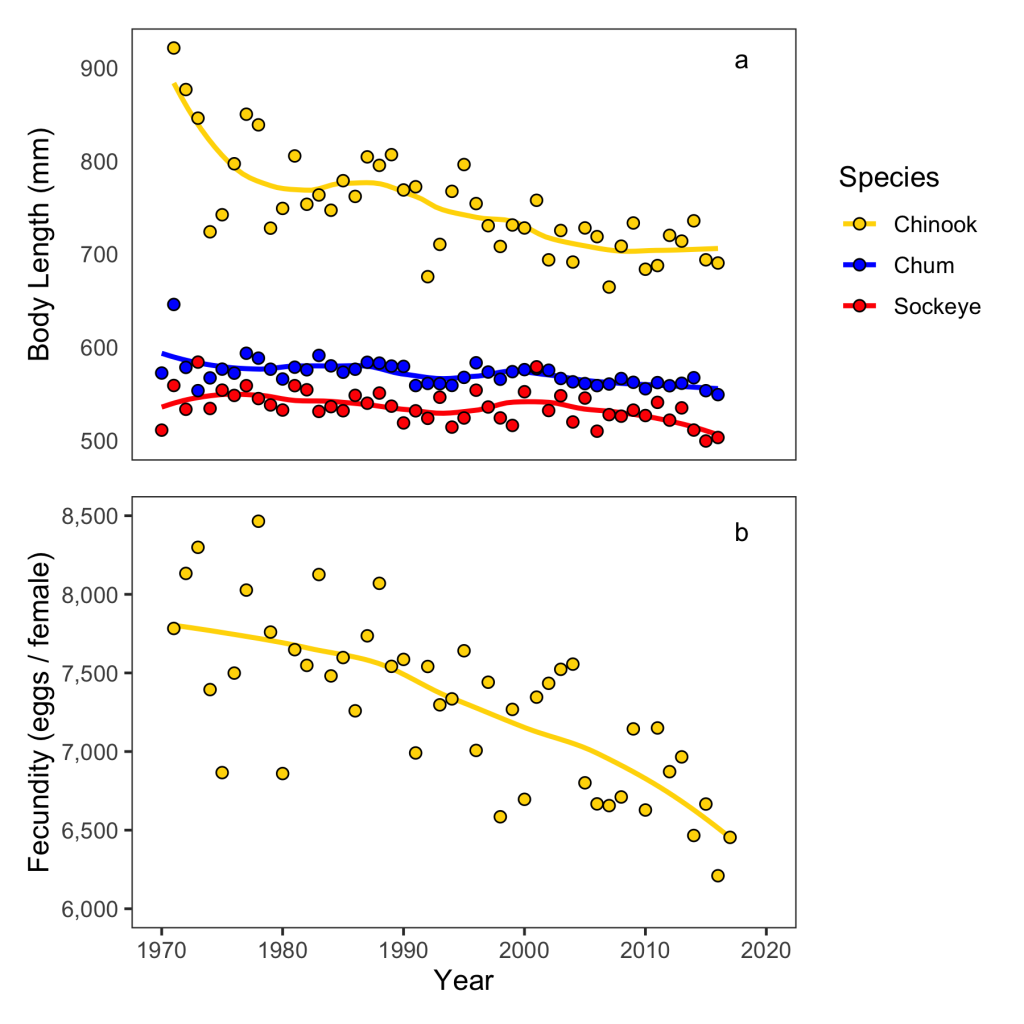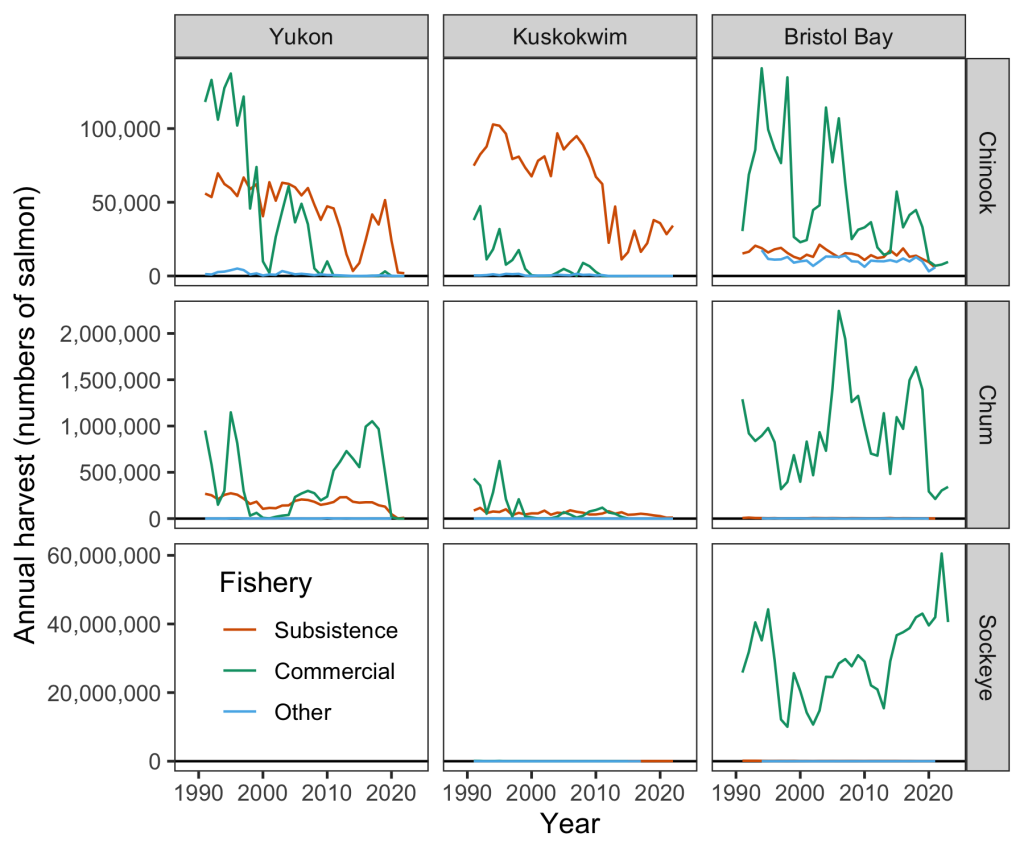E. R. Schoen1, K. G. Howard2, J. M. Murphy3, D. E. Schindler4, P. A. H. Westley5, and V. R. von Biela6
1International Arctic Research Center, University of Alaska Fairbanks, Fairbanks, AK, USA
2Division of Commercial Fisheries, Alaska Department of Fish and Game, Anchorage, AK, USA
3Auke Bay Laboratories, Alaska Fisheries Science Center, NOAA, Juneau, AK, USA
4School of Aquatic and Fishery Sciences, University of Washington, Seattle, WA, USA
5College of Fisheries and Ocean Sciences, University of Alaska Fairbanks, Fairbanks, AK, USA
6Alaska Science Center, U.S. Geological Survey, Anchorage, AK, USA
Headlines
- Western Alaska salmon abundance reached historic extremes during 2021-22, with record lows for Chinook and chum salmon (81% and 92% below the 30-year mean, respectively) and record highs for sockeye salmon (98% above the 30-year mean).
- Salmon are maturing at smaller sizes. Since the 1970s, for example, Yukon River Chinook salmon have decreased an estimated 6% in mean adult body length and 15% in fecundity, likely exacerbating population declines.
- Salmon population declines have led to fishery closures, worsened user conflicts, and had profound cultural and food security impacts in Indigenous communities that have been tied to salmon for millennia.
- Changes in abundance and size are associated with climatic changes in freshwater and marine ecosystems and competition in the ocean. Changes in predators, food supply, and disease are also likely important drivers.
Introduction
Pacific salmon populations in western Alaska have responded differently to recent climatic changes, with Chinook salmon (Oncorhynchus tshawytscha) and chum salmon (O. keta) reaching record low abundance levels, while sockeye salmon (O. nerka) have attained record high abundance levels since 2020 (Fig. 1). Why these species have responded differently has important implications for the future of Pacific salmon in a warming Arctic. Here, we refer to “western Alaska” salmon as those spawning in watersheds that drain into the eastern Bering Sea. Indigenous Peoples in this region, including First Nations communities residing along Canadian tributaries to the Yukon River, have been tied to salmon for at least 12,000 years, while commercial fisheries have been economic mainstays since the late 1800s (Carothers et al. 2021). Salmon populations in this region have global significance, producing over half of the world’s commercial catch of sockeye salmon from Bristol Bay and have historically supported the world’s largest subsistence fisheries for Chinook and chum salmon in the Yukon and Kuskokwim watersheds. These species, and to a lesser extent, pink (O. gorbuscha) and coho (O. kisutch) salmon, remain a critical source of food, employment and cash income, and cultural practices essential for communities’ well-being and traditional ways of life (Brown and Godduhn et al. 2015). We report evidence of these changes primarily through the lens of western science, focusing on a few well-studied stocks, and we acknowledge this essay does not convey the breadth of perspectives or the complexity of ecological changes across the region.


Changes in salmon abundance
Chinook salmon abundance has declined in western Alaska over several decades, culminating with the lowest adult returns on record in the Yukon River in 2022 at 81% below the recent 30-yr mean (1991-2020; Fig. 2). Adult returns reflect the numbers of maturing salmon that return to inshore waters each year, including those that return to freshwater to spawn and those that are harvested in fisheries. Chinook salmon abundance also reached record lows in other Bering Sea drainages, including the Unalakleet, Kuskokwim, and Nushagak Rivers during the last five years, mirroring recent declines of this species throughout its range in the North Pacific Ocean. Chum salmon abundance was above average during most of the 2010s, then declined abruptly in the last five years across the region, falling to a record low in 2021 at 92% below the recent 30-yr mean in the Yukon River, for example. Preliminary data indicate Chinook and chum abundance rebounded slightly in 2023 but remained well below average.


In contrast, sockeye salmon abundance has increased in western Alaska during the last decade, including a record high return to Bristol Bay in 2022 at 98% above the 30-yr mean. These record high runs have supported record harvests in fisheries while also surpassing management targets for spawner abundances. Substantial increases in sockeye salmon abundance have also been documented in the Kuskokwim River to the north of Bristol Bay.
Declines of Chinook salmon in the Yukon River have received particular attention, revealing associations with climatic and biological changes in freshwater and marine ecosystems. Most of the year-to-year variation in adult returns is correlated with the abundance of juveniles at the end of their first summer in the Bering Sea (Murphy et al. 2021). This has led researchers to focus on the early marine stage and preceding life stages in freshwater (adult spawner, embryo, and juvenile) as most influential for understanding the population declines, but no single explanation has emerged. Reduced abundance of Yukon River Chinook salmon is correlated with warmer water temperatures and lower river discharge during adult spawner migrations (Howard and von Biela 2023) and higher precipitation during juvenile rearing (Murdoch et al. 2023). These patterns suggest Chinook salmon may face increasing challenges in a warmer and rainier climate (see essays Surface Air Temperature and Precipitation). Conversely, increased abundance is correlated with warmer winter temperatures during embryo incubation and early marine residence and earlier river ice breakup during the year juveniles migrate to the ocean (Cunningham et al. 2018, Murdoch et al. 2023), suggesting potential benefits from warming trends in some cases. Traditional knowledge and western science indicate species interactions including competition, predation, food supply, and disease also influence salmon abundance (e.g., Feddern et al. 2023; Ruggerone et al. 2023). Bycatch of Chinook and chum salmon in Bering Sea trawl fisheries is also a known source of mortality, although it explains only a small fraction of historic Chinook salmon declines (Cunningham et al. 2018). Drivers of abundance of other western Alaska salmon species and populations remain less understood.
Changes in salmon size and life history
Salmon from western Alaska are returning to spawn at smaller sizes than in the past, reducing their reproductive capacity and the value of each fish to humans and ecosystems (Ohlberger et al. 2020, 2023; Oke et al. 2020). The average length of adult Chinook salmon in the Yukon River has declined by 5-7% since the 1970s, contributing to estimated losses of 13-20% in fecundity and 24-35% in total egg mass and likely reinforcing long-term population declines (Ohlberger et al. 2020; Fig. 3). Western Alaska chum and sockeye salmon have shown smaller declines in body size.


Changes in the size of spawning salmon are explained by earlier maturation and reduced growth rates. After hatching, Chinook salmon in western Alaska typically spend one year rearing in streams and rivers before migrating to the ocean, where they spend 1-5 years maturing before returning to spawn in fresh water. Chinook salmon are smaller at a given age and are maturing at younger ages than in the past (Ohlberger et al. 2020). Chum salmon swim to the ocean immediately after emerging from the gravel, and trends in age at maturity are less clear. Sockeye salmon spend 1-2 years rearing in fresh water (mostly in lakes, but sometimes in rivers). In Bristol Bay, the warming climate has led to a decline in the number of sockeye salmon that rear for two years in lakes, with most fish now leaving fresh water after one year. This shift in freshwater age and declining growth rates in the ocean have led to more fish spending three rather than two years in the ocean and returning to spawn at smaller average sizes (Cline et al. 2019; Ohlberger et al. 2023).
Changes in growth and age of maturity of western Alaska Chinook salmon have been linked to changes in ocean climate (Siegel et al. 2017), and selective predation of larger individuals may also be contributing to accelerated maturation (e.g., Manishin et al. 2021). Though these trends are observed throughout the North American range of Chinook salmon, they are particularly marked in western Alaska stocks (Ohlberger et al. 2018). Changes in growth and energy allocation in juvenile chum salmon are associated with a marked loss of sea ice and decline in prey energy density during a recent (2014-2019) warm period with marine heatwaves in the Bering Sea (Farley et al. 2024). Declining body sizes of sockeye salmon in Bristol Bay are most strongly associated with their own increasing abundance, and secondarily with increasing abundance of chum and pink salmon in the North Pacific Ocean and warming sea surface temperatures (see essay Sea Surface Temperature). These patterns have been associated with intra- and inter-specific competition for food in the ocean, possibly exacerbated by climate warming (Ohlberger et al. 2023; Ruggerone et al. 2023).
Implications for fisheries and people
Depressed abundances of salmon create problems for fisheries and the people that depend on them. Low returns of Chinook and chum salmon to the Yukon and Kuskokwim Rivers have resulted in closed or heavily restricted subsistence, commercial, and sport fisheries, including unprecedented complete closures of salmon-directed fisheries on the Yukon River during 2021-22 and very limited openings during 2023 (JTC 2023; Fig. 4). Tribal and local leaders are raising their voices to communicate how the synchronous collapse of multiple salmon populations and species has created a region-wide crisis in communities reliant on salmon for food security, culture, mental health, and a way of life (Brown and Godduhn 2015; Feddern et al. 2023). Fish camps sit empty, fishing gear is not maintained, and younger generations are not able to learn the fishing and processing techniques that have been refined over thousands of years when there are no fish to be caught (Brown and Godduhn 2015; Sakati 2023). Harvests of alternative wild foods including fish, birds, and moose have increased where possible, but have also added concerns about the sustainability of those resources. The need to protect Chinook and chum salmon limits the harvest of other fish species that co-occur in fishing areas. Commercial salmon fishery restrictions and closures curtail a source of otherwise scarce jobs and economic development in the region. Federal Fishery Disaster Determinations were granted for the 2020 and 2021 salmon fisheries in the Yukon and Kuskokwim Rivers and Norton Sound and the 2022 salmon fishery in the Yukon River, among other Alaska fisheries (NOAA 2023).


At the other extreme, historically high sockeye salmon returns in Bristol Bay have boosted economic opportunities, but also introduced sources of conflict. The Bristol Bay commercial harvest of 60 million sockeye salmon in 2022 was a record high in a fishery dating back to 1883, exceeding the previous record set in 1995 by 36% (Fig. 4). However, extremely high sockeye harvests in consecutive years, in concert with record catches of pink salmon globally, have outpaced global demand for salmon products, leading to severe reductions in prices paid to commercial fishers. Low prices can drive western Alaska fishers to sell their commercial permits to those outside the region, with lasting implications for local economies (Carothers et al. 2021). Mixed-stock fisheries along the coast of the Alaska Peninsula targeting abundant sockeye salmon also harvest chum salmon bound for western Alaska (Dann et al. 2023). This introduces conflict in how chum salmon are prioritized between subsistence and commercial fisheries and has the potential to impact their recovery and the human communities that depend on them.
Many organizations are working to restore salmon abundance and habitat in watersheds impacted by human activity, including 125 years of placer mining (e.g., BLM 2023). Community-based monitoring programs are incorporating local and traditional knowledge into research and management decisions (Feddern et al. 2023), as has proven successful in northern Alaska (see essay Nunaaqqit Savaqatigivlugich: Working with Communities to Observe the Arctic). Other proposed actions include limiting chum salmon bycatch in marine fisheries, limiting harvest of western Alaska salmon in coastal mixed stock fisheries, establishing hatcheries in western Alaska, and limiting hatchery enhancement of pink and chum salmon stocks in other parts of Alaska and the North Pacific that may compete with western Alaska salmon in the ocean (AFN 2022; Feddern et al. 2023; Herz 2023; Ruggerone et al. 2023). All of these proposed actions involve trade-offs and are hotly debated. While the rapidly changing climate appears to be an important driver of salmon abundance, more work is needed to understand the causal mechanisms and to develop policy actions that are responsive to changing salmon abundance and demographics. Actionable research at the science-policy interface is needed to understand how decisions at local, regional, and global levels can most effectively support salmon recovery, sustainable fisheries, and the well-being of people in a warming world.
Methods and data
Salmon abundance was estimated using run reconstruction models by the Alaska Department of Fish and Game (ADF&G) and the Joint Technical Committee of the US/Canada Yukon River Panel (e.g., JTC 2023). These models use information on harvest in mixed-stock and terminal fisheries, stock composition data, and estimates of spawning abundance to determine the total numbers of maturing salmon that returned to in-shore waters. Body length measurements were compiled by Oke et al. (2020) from ADF&G data. We filtered these data to include only salmon captured in western Alaska using minimally size-selective gear (weirs, seines, and carcass surveys). Fecundity of Chinook salmon was estimated from body length using an empirical length-fecundity relationship from the Yukon River by Ohlberger et al. (2020). Fisheries harvest data were provided by ADF&G. All data and code are available at https://github.com/eschoen/ArcticReportCard-Salmon.
Acknowledgments
We are grateful to the many knowledge holders, managers, and scientists who contributed to the long-term datasets and understanding included in this report. We especially thank ADF&G staff for compiling and sharing the salmon abundance and harvest data. Any use of trade, firm, or product names is for descriptive purposes only and does not imply endorsement by the U.S. Government.
References
AFN (Alaska Federation of Natives), 2022 AFN Resolutions. https://www.nativefederation.org/wp-content/uploads/2023/04/Final-2022-Resolutions.2.pdf (Accessed 2 October 2023).
BLM (Bureau of Land Management), 2023: Gravel to Gravel Keystone Initiative. https://www.blm.gov/programs/aquatic-resources/alaska/gravel-gravel-keystone-initiative (Accessed 1 September 2023).
Brown, C. L., and A. R. Godduhn (Eds.), 2015: Socioeconomic effects of declining salmon runs on the Yukon River (Technical Paper No. 398). Alaska Department of Fish and Game, Division of Subsistence, http://www.adfg.alaska.gov/techpap/TP398.pdf.
Carothers, C., and Coauthors, 2021: Indigenous peoples and salmon stewardship: a critical relationship. Ecol. Soc., 26, 16, https://doi.org/10.5751/es-11972-260116.
Cline, T. J., J. Ohlberger, and D. E. Schindler, 2019: Effects of warming climate and competition in the ocean for life-histories of Pacific salmon. Nat. Ecol. Evol., 3, 935-942, https://doi.org/10.1038/s41559-019-0901-7.
Cunningham, C. J., P. A. H. Westley, and M. D. Adkison, 2018: Signals of large scale climate drivers, hatchery enhancement, and marine factors in Yukon River Chinook salmon survival revealed with a Bayesian life history model. Global Change Biol., 24, 4399-4416, https://doi.org/10.1111/gcb.14315.
Dann, T. H., H. A. Hoyt, E. M. Lee, E. K. C. Fox, and M. B. Foster, 2023: Genetic stock composition of chum salmon harvested in commercial salmon fisheries of the South Alaska Peninsula, 2022. Alaska Department of Fish and Game, Special Publication No. 23-07, Anchorage, https://www.adfg.alaska.gov/FedAidPDFs/SP23-07.pdf.
Farley, E. V., Jr., E. M. Yasumiishi, J. M. Murphy, W. Strasburger, F. Sewall, K. Howard, S. Garcia, and J. H. Moss, 2024: Critical periods in the marine life history of juvenile western Alaska chum salmon in a changing climate. Mar. Ecol. Prog. Ser., 726, 149-160, https://doi.org/10.3354/meps14491.
Feddern, M. L., and Coauthors, 2023: Kings of the north: Bridging disciplines to understand the effects of changing climate on Chinook salmon in the Arctic-Yukon-Kuskokwim region. Fisheries, 48, 331-343, https://doi.org/10.1002/fsh.10923.
Herz, N., 2023: Fish hatcheries, long seen as a last resort, get a new look amid Yukon River salmon crisis. Northern Journal, 7 April 2023. https://northernjournal.substack.com/p/fish-hatcheries-long-seen-as-a-last?utm_source=post-email-title&publication_id=1057678&post_id=113385992&isFreemail=true&utm_medium=email.
Howard, K. G., and V. von Biela, 2023: Adult spawners: A critical period for subarctic Chinook salmon in a changing climate. Global Change Biol., 29, 1759-1773, https://doi.org/10.1111/gcb.16610.
JTC (Joint Technical Committee of the Yukon River U.S./Canada Panel), 2023: Yukon River salmon 2022 season summary and 2023 season outlook. Alaska Department of Fish and Game, https://www.yukonriverpanel.com/download/13/joint-technical-committee-reports/3775/yukon-jtc-23-01-2022-season-review-2023-outlook.pdf.
Manishin, K. A., C. J. Cunningham, P. A. H. Westley, and A. C. Seitz, 2021: Can late stage marine mortality explain observed shifts in age structure of Chinook salmon? PLoS One, 16, e0247370, https://doi.org/10.1371/journal.pone.0247370.
Murdoch, A. D., B. M. Connors, N. W. R. Lapointe, J. Mills Flemming, S. J. Cooke, and C. Mantyka-Pringle, 2023: Multiple environmental drivers across life-stages influence Yukon River Chinook salmon productivity. Can. J. Fish. Aquat. Sci., https://doi.org/10.1139/cjfas-2022-0254.
Murphy, J., and Coauthors, 2021: Northern Bering Sea surface trawl and ecosystem survey cruise report, 2019. U.S. Department of Commerce, NOAA Tech. Memo, NMFS-AFSC-423, 124 p., https://repository.library.noaa.gov/view/noaa/32075.
NOAA (National Oceanic and Atmospheric Administration), 2023: Fishery Disaster Determinations. https://www.fisheries.noaa.gov/national/funding-and-financial-services/fishery-disaster-determinations (Accessed 29 September 2023).
Ohlberger, J., E. J. Ward, D. E. Schindler, and B. Lewis, 2018: Demographic changes in Chinook salmon across the Northeast Pacific Ocean. Fish Fish., 19, 533-546, https://doi.org/10.1111/faf.12272.
Ohlberger, J., D. E. Schindler, R. J. Brown, J. M. S. Harding, M. D. Adkison, A. R. Munro, L. Horstmann, and J. Spaeder, 2020: The reproductive value of large females: consequences of shifts in demographic structure for population reproductive potential in Chinook salmon. Can. J. Fish. Aquat. Sci., 77(8), 1292-1301, https://doi.org/10.1139/cjfas-2020-0012.
Ohlberger, J., T. J. Cline, D. E. Schindler, and B. Lewis, 2023: Declines in body size of sockeye salmon associated with increased competition in the ocean. Proc. Roy. Soc. B.-Biol. Sci., 290, 20222248, https://doi.org/10.1098/rspb.2022.2248.
Oke, K. B., and Coauthors, 2020: Recent declines in salmon body size impact ecosystems and fisheries. Nat. Commun., 11, 4155, https://doi.org/10.1038/s41467-020-17726-z.
Ruggerone, G. T., A. M. Springer, G. B. van Vliet, B. Connors, J. R. Irvine, L. D. Shaul, M. R. Sloat, and W. I. Atlas, 2023: From diatoms to killer whales: impacts of pink salmon on North Pacific ecosystems. Mar. Ecol. Prog. Ser., 719, 1-40, https://doi.org/10.3354/meps14402.
Sakati, C., 2023: Fishing in the desert: Modernizing Alaskan salmon management to protect fisheries and preserve fishers’ livelihoods. Alaska Law Review, 40, 137-169, https://scholarship.law.duke.edu/alr/vol40/iss1/6/.
Siegel, J. E., M. V. McPhee, and M. D. Adkison, 2017: Evidence that marine temperatures influence growth and maturation of western Alaskan Chinook salmon. Mar. Coast. Fish., 9, 441-456, https://doi.org/10.1080/19425120.2017.1353563.
January 23, 2024
